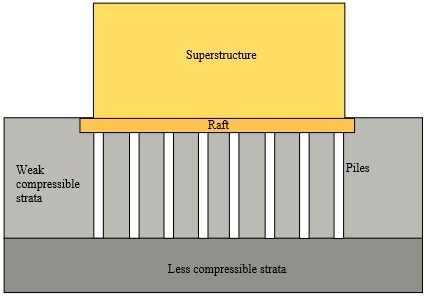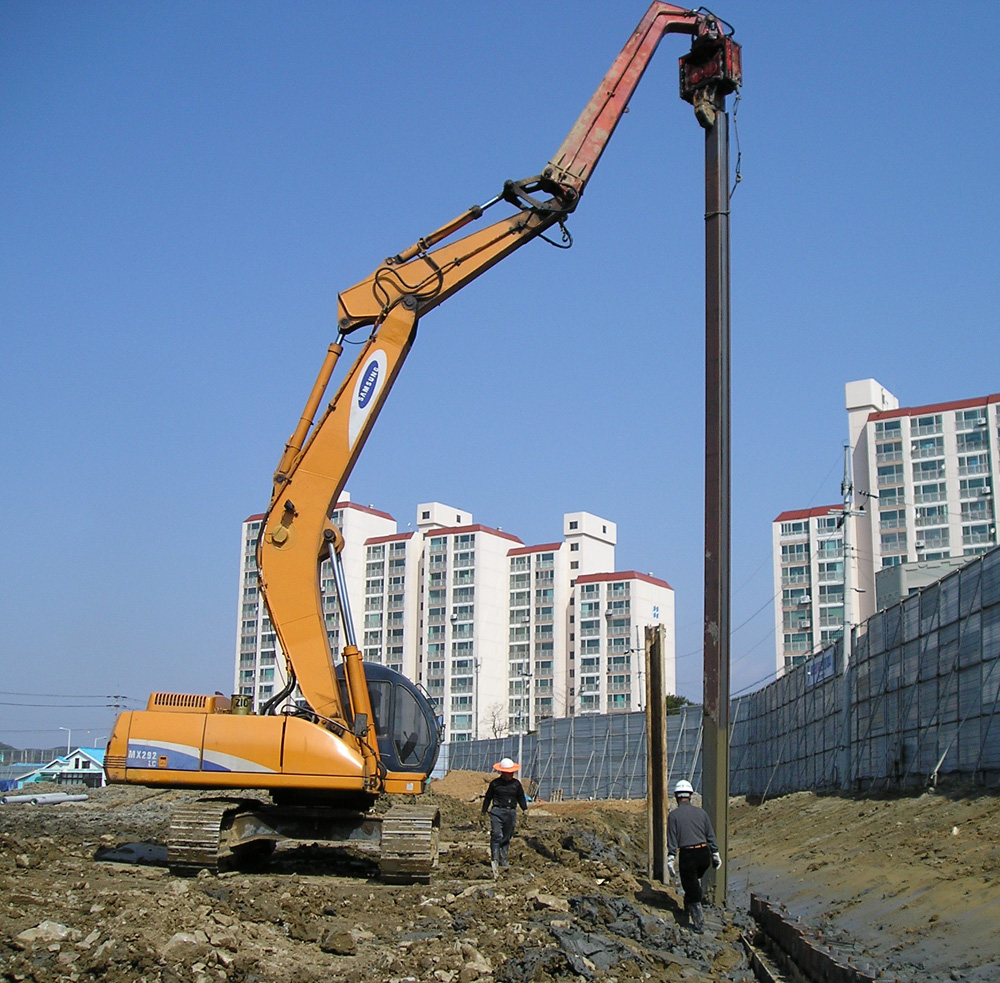Piling mat
Pile foundations are a type of deep foundation, principally used to transfer loads from superstructures, through weak, compressible strata or water onto stronger, more compact, less compressible and stiffer soil or rock at depth. They are formed by long, slender, columnar elements typically made from steel or reinforced concrete, or sometimes timber.
They are constructed by displacement (driven) or replacement (bored).

|

|
A piling mat is a type of working platform used for piling rigs to travel on, providing a stable base on which they can move around the site and operate.
The design of piling mats will depend on the ground conditions and the piling equipment being used, as well as the rig loadings (which typically range from 5 to over 150 tonnes). If a piling mat is too deep it will be incurring unnecessary costs, whilst if it is too shallow it may need time- and cost-inefficient repairs. A soft spot in the surface of just 1 sq. m, can be enough to unbalance a rig.
Typically, the top of a piling mat will be around 600 mm above the pile cut-off level, and it will extend beyond the outermost pile positions by at least 2 m. The edges of the mat and the ramps onto and off it should be clearly marked.
The most suitable materials for piling mats are generally well-graded natural gravels, clean-crushed concrete, crushed hard rock, and so on. As long as it has rebar and timber removed, graded recycled demolition material can also be used. Mats are rolled and compacted in layers. The mat should be free-draining to prevent any build-up of water or slurry on its surface. On sites with a high water table, a separating membrane may be positioned between the mat and the sub-grade to prevent the upward migration of fine-grained soils into the mat.
Piling mats should be inspected daily to ensure they are in proper working condition. If any excavations, trenches or holes have formed in the surface, they must be properly backfilled to ensure they are as stable as the rest of the mat.
It is mandatory that every site with an operational piling rig has a Working Platform Certificate (WPC) that states the piling mat has been correctly designed and installed. The WPC must be signed by the principal contractor and provided for the piling contractor before any piling commences on the site.
[edit] Find out more
[edit] Related articles on Designing Buildings Wiki
Featured articles and news
CIOB report; a blueprint for SDGs and the built environment
Pairing the Sustainable Development Goals with projects.
Latest Build UK Building Safety Regime explainer published
Key elements in one short, now updated document.
UKGBC launch the UK Climate Resilience Roadmap
First guidance of its kind on direct climate impacts for the built environment and how it can adapt.
CLC Health, Safety and Wellbeing Strategy 2025
Launched by the Minister for Industry to look at fatalities on site, improving mental health and other issues.
One of the most impressive Victorian architects. Book review.
Common Assessment Standard now with building safety
New CAS update now includes mandatory building safety questions.
RTPI leader to become new CIOB Chief Executive Officer
Dr Victoria Hills MRTPI, FICE to take over after Caroline Gumble’s departure.
Social and affordable housing, a long term plan for delivery
The “Delivering a Decade of Renewal for Social and Affordable Housing” strategy sets out future path.
A change to adoptive architecture
Effects of global weather warming on architectural detailing, material choice and human interaction.
The proposed publicly owned and backed subsidiary of Homes England, to facilitate new homes.
How big is the problem and what can we do to mitigate the effects?
Overheating guidance and tools for building designers
A number of cool guides to help with the heat.
The UK's Modern Industrial Strategy: A 10 year plan
Previous consultation criticism, current key elements and general support with some persisting reservations.
Building Safety Regulator reforms
New roles, new staff and a new fast track service pave the way for a single construction regulator.
Architectural Technologist CPDs and Communications
CIAT CPD… and how you can do it!
Cooling centres and cool spaces
Managing extreme heat in cities by directing the public to places for heat stress relief and water sources.
Winter gardens: A brief history and warm variations
Extending the season with glass in different forms and terms.
Restoring Great Yarmouth's Winter Gardens
Transforming one of the least sustainable constructions imaginable.
























Comments
Please state where, other than on the PSF website, it is mandated that a WPC to be used as verification of a piling mat. As temporary works, a working platform could be commissioned through a permit to load like any other BS 5975-managed system.